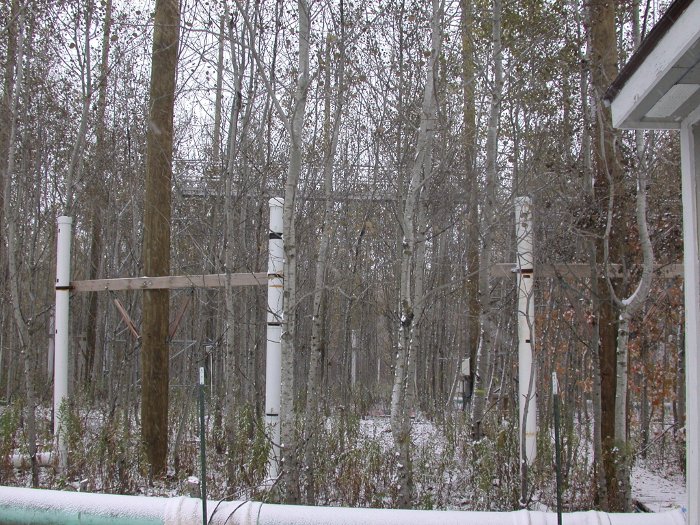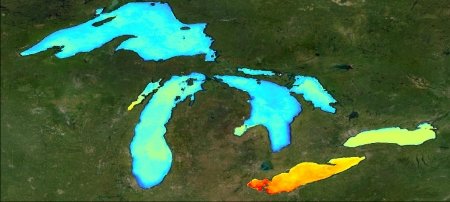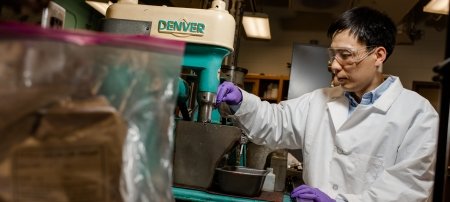Trees Find the Nitrogen They Need, Even in a Super-Size CO2 World

In the fast-food world of trees, let’s say carbon dioxide is like French fries, and nitrogen is like catsup. Suppose those trees suddenly had extra servings of French fries, but the catsup ration stayed put.
You’d think they’d run out of catsup. You might even think that trees would slow their growth from not having enough catsup to balance their French fry diet, since catsup is a vegetable and an important nutrient. But you’d be wrong. Instead, some trees are finding the extra catsup they need and are doing just fine, at least for now.
The evidence stems from Aspen FACE, which opened a window on the future of northern forests. This Rhinelander, Wis.–based study exposed trees to elevated levels of carbon dioxide and ozone from 1999 until its conclusion in 2009. Early results proved that adding extra carbon dioxide to the atmosphere would speed tree growth. But growing trees also need more nitrogen, which they get not from the air but from organic matter in the soil. What effect would all that CO2-super-powered growth have on the nitrogen cycle?
Initially, scientists thought that trees with a heartier appetite for nitrogen might cause levels in the soil to drop, eventually leading to slower growth. “That didn’t happen,” said Andrew Burton, an associate professor of forest resources and environmental science at Michigan Technological University. Instead, the trees root systems more fully explored the soil for nitrogen, and leaf litter and other organic matter was decomposing more quickly, making more nitrogen available. “It’s being recycled faster,” he said.
However, another greenhouse gas can affect which trees get that nitrogen: ozone, which is toxic to many types of vegetation. The Aspen FACE study exposed plots containing a variety of trees to a cocktail of carbon dioxide and ozone. Initially, forest growth was stunted. But over the years, ozone-sensitive varieties of aspen died or just limped along. The ozone-resistant varieties proliferated, and the forest eventually behaved as if there were no ozone in the atmosphere at all.
What this means for climate change
Forests are carbon sinks. By sucking the CO2 out of the atmosphere, they are thought to help mitigate climate change brought on by rising concentrations of greenhouse gases. Ozone was supposed to interfere with that process, since it weakens trees, but this study shows that at least some trees can overcome ozone’s harmful effects. However, said Burton, there’s a price to be paid.
“If the ozone-sensitive trees die out, and others thrive, are you losing genetic diversity?” he asked. “We could be losing other attributes, like drought tolerance, that could be important in the future.”
Clear-cutting Aspen FACE
Back in the 1990s, the US Department of Energy provided major support for four Free Atmospheric Carbon dioxide Enrichment experiments across the US. These FACE sites exposed trees to elevated levels of carbon dioxide, with the aim of determining how forests would react to the atmosphere of the future.
Michigan Tech managed the site in Rhinelander, which was the sole FACE site that also investigated the effects of ozone. It focused primarily on aspen, though it also studied paper birch and sugar maple trees.
Now, after 11-1/2 years, all the FACE sites have been cut down. It became too expensive to keep the long-running experiments going, especially as trees matured and carbon dioxide had to be pumped into the treetops, Burton noted. The final grant to fund the Rhinelander study, issued in 2008, was nearly $4 million.
“Nobody wanted to see it end, but we are grateful to the DOE for the support it gave for many years at that level,” he said.
“Aspen FACE would never have happened without the visionary efforts of the late Dave Karnosky and his collaborators,” Burton added. “More than 100 scientists from eight countries have worked there, leading to well over 100 publications.”
Karnosky, a professor of forest resources and environmental science, directed Aspen FACE until his death in 2008.
After Aspen FACE
Scientists are still compiling the results from their research at Aspen FACE. And, as the second generation of trees sprouted, the site had a brief second incarnation. The new Northern Forest Ecosystem Experiment, funded by the USDA Forest Service, allowed scientists to study the first year of new growth.
In addition, wood samples from the trees grown at Aspen FACE have been placed at 11 forest locations around the country to help researchers understand where the carbon in decomposing wood ends up; one possibility is that some of it could be stored long-term in the soil. So even though the big trees are gone, the discoveries should be coming out for a long time to come.
The research findings above appear in two articles coauthored by Donald Zak, Mark Kubiske, Kurt Pregitzer and Burton: “Atmospheric CO2 and O3 Alter Competition for Soil Nitrogen in Developing Forests,” published in Global Change Biology, volume 11; and “Forest Productivity under Elevated CO2 and O3: Positive Feedbacks to Soil N Cycling Sustain Decade-Long Net Primary Productivity Enhancement by CO2,” published in Ecology Letters, volume 14.
Michigan Technological University is a public research university founded in 1885 in Houghton, Michigan, and is home to more than 7,000 students from 55 countries around the world. Consistently ranked among the best universities in the country for return on investment, Michigan’s flagship technological university offers more than 120 undergraduate and graduate degree programs in science and technology, engineering, computing, forestry, business and economics, health professions, humanities, mathematics, social sciences, and the arts. The rural campus is situated just miles from Lake Superior in Michigan's Upper Peninsula, offering year-round opportunities for outdoor adventure.




Comments